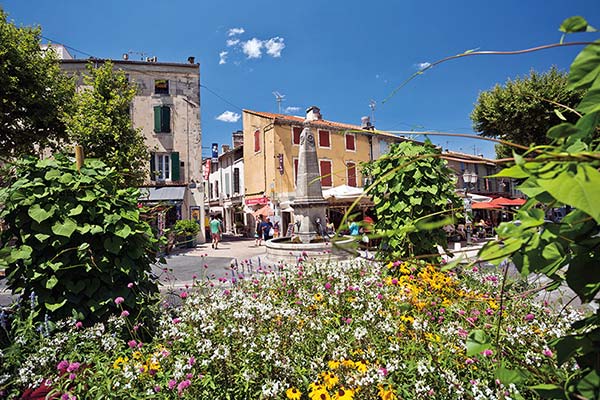
Welcome to Rick Steves’ Europe
How to Shop in a French Market
Provence and the French Riviera’s Top Destinations
Map: PLACES COVERED IN THIS BOOK
Best Two-Week Trip of Provence & the French Riviera by Car
Best Two-Week Trip of Provence & the French Riviera by Train and Bus
Stick This Guidebook in Your Ear!
The Language Barrier and That French Attitude
Provence and the French Riviera are an intoxicating bouillabaisse of enjoyable cities, warm stone villages, Roman ruins, contemporary art, and breathtaking coastlines steaming with sunshine and stirred by the wind. There’s something about the play of light in this region, where natural and man-made beauty mingle to dazzle the senses and nourish the soul. It all adds up to une magnifique vacation.
Provence and the Riviera stretch along France’s southeast Mediterranean coast from the Camargue (south of Arles) to Monaco, and ramble north along the Rhône Valley into the Alps. The regions combined are about the same size as Massachusetts—you can take a train or drive from one end to the other in just three hours—yet they contain more sightseeing opportunities and let’s-live-here villages than anywhere else in France. Marseille and Nice, the country’s second- and fifth-largest cities, provide good transportation and an urban perspective to this otherwise laid-back region, where every day feels like Sunday.
As you travel through this splendid slice of France, slo-o-o-ow down. Take time to smell the fougasse, spend hours in cafés dawdling over un café, and make a habit of unplanned stops. Here in France, l’art de vivre—the art of living—is not just a pleasing expression; it’s a building block for a sound life. With five weeks of paid vacation, plus every Catholic holiday ever invented, the French have become experts at living well. It’s no accident that France is home to linger-longer pastimes like café lounging, fine dining, and barge cruising. The French insist on the highest-quality beverages and food (whether it’s sparkling water, croissants, cheese, or even mustard). They don’t rush lunch, and an evening’s entertainment is usually no more than a lovingly prepared meal with friends.
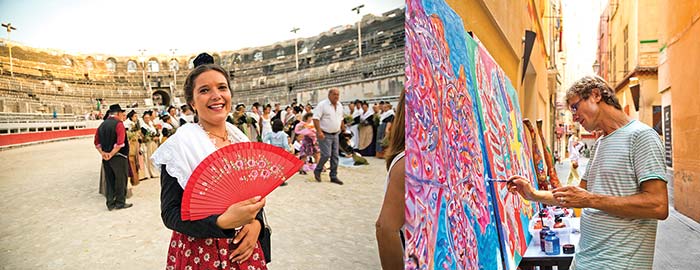
Artists are drawn to the region’s colorful variety—shown by this splash of Spain at Arles’ Roman Arena.
While both Provence and the Riviera share a relaxed pace, each region has a distinct vibe. Provence feels older and more español (with paella on menus and bullfights on Sundays), while the Riviera feels downright Italian—with fresh-Parmesan-topped pasta and terra-cotta-colored buildings. For every Roman ruin in Provence, there’s a modern-art museum in the Riviera. Provence is famous for its wines and wind, while the bikini and ravioli were conceived on the Riviera.
Sunbaked and windswept, Provence has a rustic charm and feels more working-class and earthy. This area was named for being the first “foreign” conquest as ancient Rome set about building its vast empire. Since it wasn’t Rome proper, they called it “Provincia Romana” (province of Rome)—and the name stuck. The Romans left behind some remarkable examples of engineering in their first province, including the Pont du Gard, built in about 19 BC, one of the most striking—and impressive—sights in all of France. In the ancient world, water-bearing aqueducts were like flags of stone that heralded the greatness of Rome. You’ll find a variety of other Roman ruins in Provence, from entire towns to outdoor theaters and sports arenas where gladiators dueled.
Throughout Provence, gnarled sycamores line roads that twist their way through stone towns and between oceans of vineyards. In small squares in every Provençal village and city, you’re likely to find the local gang playing boules, the horseshoes of southern France. Pause and watch old-timers while away the afternoon tossing shiny silver balls on gravelly courts—and give it a try yourself.
France’s Riviera conjures images of sea and money—it’s populated by a yacht-happy crowd wondering where the next “scene” will be. The Riviera, called la Côte d’Azur by locals, was a remote backwater until the late 18th-century, when it gained fame as a resort town among British aristocrats. In 1864 the first rail service made Nice and the Riviera more accessible, drawing the likes of Czar Alexander II of Russia and Queen Victoria. By the end of the 19th century, the area’s sunny glow attracted painters such as Henri Matisse, Pablo Picasso, and Auguste Renoir. The weather and locale still draw in jet-setters, celebrating sunny beaches and yacht-filled harbors. In towns all along the Riviera, graceful buildings from the turn-of-the-last-century line the harborfront—reminders of the belle époque. It was literally the “beautiful age,” when the world seemed to revolve around the upper class and indulgence with abandon was a lifestyle. Some of the Riviera’s best scenery is in the interior, where you’ll find cozy hill towns with panoramic views (Vence, St-Paul-de-Vence, and sky-high Eze-le-Village)—along with art galleries and boutiques.

Try playing boules, a popular sport at parks. Stroll through streets bordered by Roman ruins.
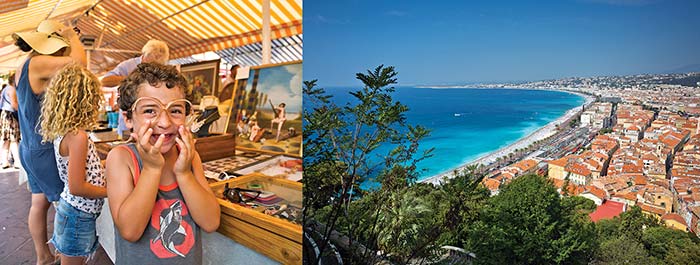
Browse the market for a new look. Climb up Nice’s Castle Hill for a French Riviera view.
Throughout your travels in Provence and the French Riviera, marvel at ancient monuments, take a canoe trip down the meandering Sorgue River, and settle into a shaded café on a made-for-movies square. Enjoy tasty-yet-affordable wines while feasting on a healthy cuisine bursting with olives, tomatoes, and spices. Claim your favorite beach to call home, and at day’s end dive headfirst into a southern France sunset. You’ll experience the best this lovely region has to offer.
Oh la la! There’s so much to see in this compact and fascinating part of France. To help you decide where to spend your time, we’ve rated both regions’ top destinations and suggested a minimum number of days to allow in each.
If you build your trip around the top-rated ▲▲▲ sights, you’ll get an unforgettable introduction to the best of Provence and the French Riviera.
Depending on your time and interests, weave any of the lower-ranked sights (rated ▲ and ▲▲) into your trip. It’s easy to add some destinations based on proximity; if you’re going to Nice, Antibes is next door.
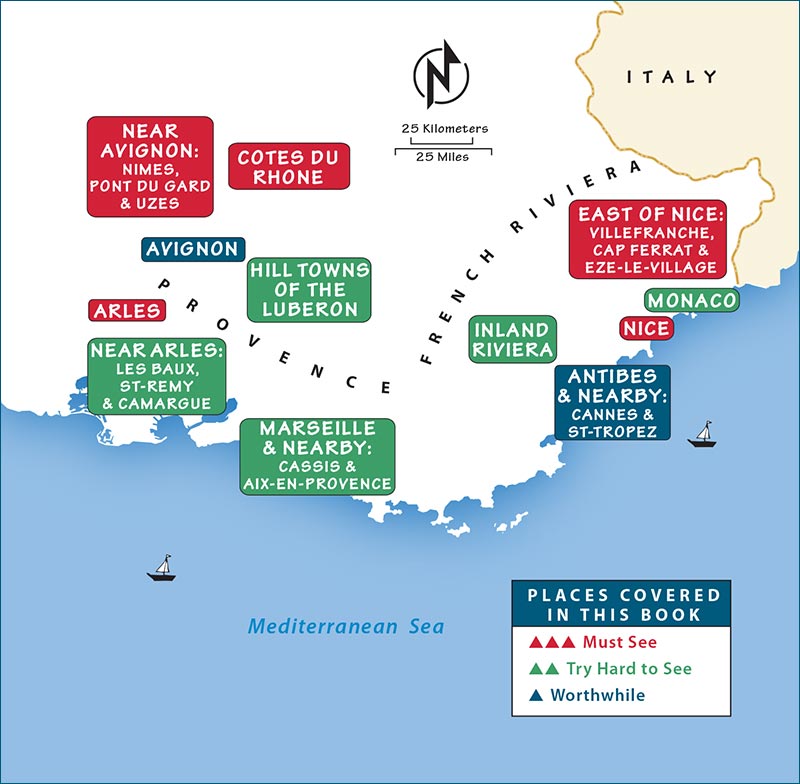
Most choose Arles or Avignon as a home base. Drivers have more options (St-Rémy-de-Provence or the more remote Vaison-la-Romaine or Roussillon).
If you’re short on time, I’d prioritize Arles, take day trips to the Pont du Gard and Les Baux, spend a night or two in a Côtes du Rhône village, and see the ▲▲▲ sights in the French Riviera (described in the next section).
This once-important Roman outpost is now a bustling town, famous for its market days, an ancient amphitheater still used for summer “bullgames,” and Vincent van Gogh sights. The town’s engaging museums cover ancient history, Van Gogh-inspired works, and modern art.
Three worthy destinations combine well for a memorable (if busy) day trip from Avignon: the stunning Pont du Gard aqueduct; thriving Nîmes, with world-class Roman monuments; and pedestrian-friendly Uzès, a refreshing break from power monuments and busy cities.
Charming Vaison-la-Romaine makes a good home base for exploring the Côtes du Rhône region, with its sunbaked sunny wine road through picturesque villages and fields of lavender. Nearby Orange hosts a remarkably intact Roman theater and a lively town center.
A bullgame in Arles (bulls survive it), Côtes du Rhône village (Gigondas), Pont du Gard aqueduct, Roman theater at Orange—still hosting events
Several compelling sights are within a stone’s throw of Arles: the cliff-topping castle ruins at Les Baux; St-Rémy with Roman ruins and a mental hospital that treated Van Gogh; and the Camargue—a nature lover’s refuge, with flamingos, bulls, and white horses.
The windswept Luberon region features crumbled castles and cliff-hanging villages, ocher canyons, and meditative abbeys; the watery market town of Isle-sur-la-Sorgue; and the delightful rock-top villages of Roussillon, Lacoste, and Ménerbes.
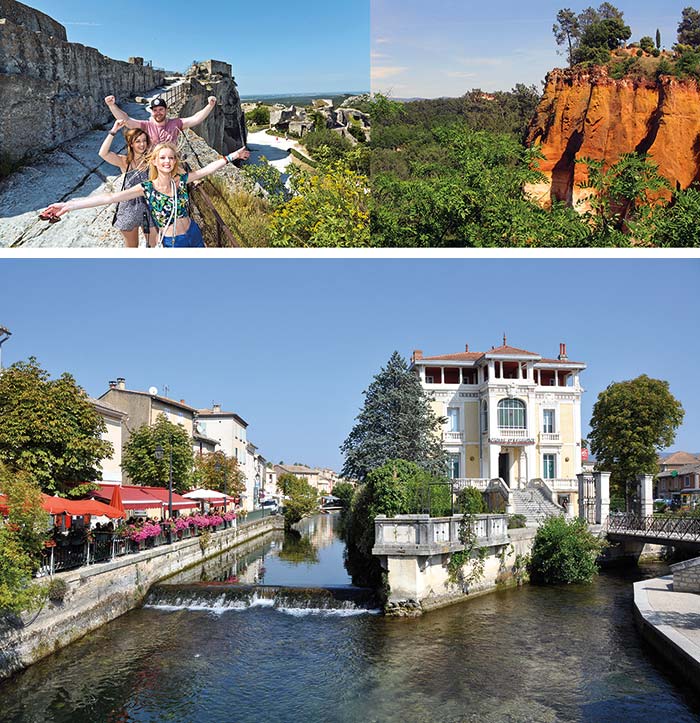
Medieval castle fun at Les Baux, red rock cliffs of Roussillon, river-straddling town of Isle-sur-la-Sorgue
The photogenic port of Marseille has a gritty charm; the beach town of Cassis is home to the calanques (Mediterranean fjords); and inland is the genteel city of Aix-en-Provence, famous for its market-filled squares.
Fourteenth-century residence of the popes, today’s youthful city hosts atmospheric cafés, lively squares and pedestrian areas, and a famous broken bridge.
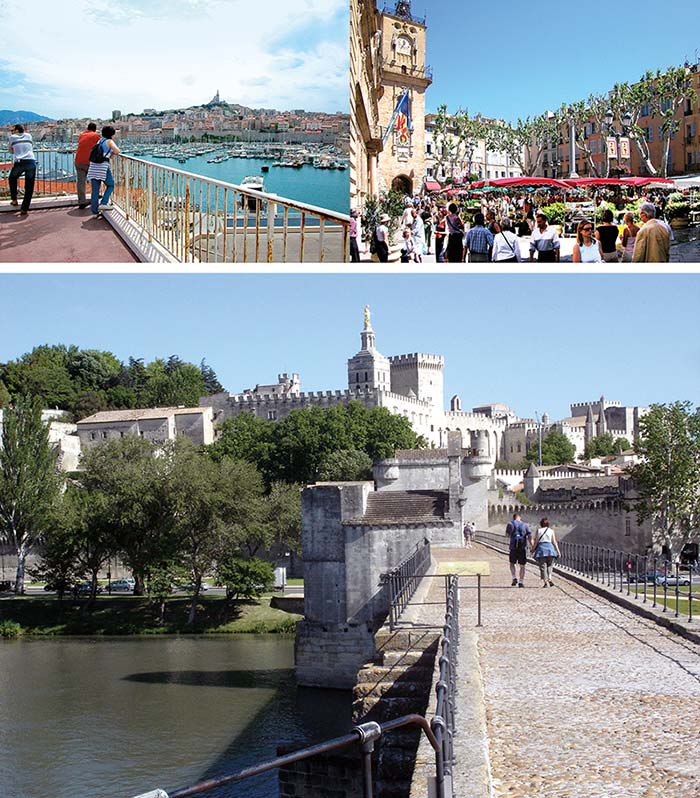
Marseille’s harbor viewpoint, market day in Aix-en-Provence, historic Palace of the Popes in Avignon
For a home base, choose among Nice, Villefranche-sur-Mer, or Antibes.
The Riviera’s metropolis, with a sun-drenched promenade, is a delightful Franco-Italian mashup, with a lively old city, the finest Russian Cathedral outside Russia, plus museums dedicated to Chagall and Matisse.
The small, romantic beach town of Villefranche-sur-Mer, ritzy but woodsy Cap Ferrat, and little cliff-topping Eze-le-Village are linked by the panoramic roads known as the Three Corniches.
Run as part of France, this tiny independent principality is known for its Grand Prix car race and classy casino.
To really do this region justice, head inland to the perfectly perched hill towns of Vence and St-Paul-de-Vence (France’s most-visited village), the perfume capital of Grasse, and the spectacular Grand Canyon du Verdon.
The Riviera’s west stars laid-back Antibes, with a medieval old town wrapped around a sharp Picasso Museum; glamorous Cannes, with sandy beaches and movie stars; and the luxurious port town of St-Tropez.
To plan your trip, you’ll need to design your itinerary—choosing where and when to go, how you’ll travel, and how many days to spend at each destination. For my best advice on sightseeing, accommodations, restaurants, and transportation, see the Practicalities chapter.
As you read this book and learn your options...
My recommended itinerary (see the sidebars) gives you an idea of how much you can reasonably see in 14 days, but you can adapt it to fit your own interests and time frame.
Focus on Provence if you want to explore the many ancient Roman ruins scattered throughout the region (Arles, Pont du Gard, Nîmes, Orange, St-Rémy, and more). Wine lovers savor the Côtes du Rhône wine road and pop corks at the famous Châteauneuf-du-Pape. For meandering exploration, the hilly Luberon satisfies drivers, hikers, and hardy bikers.
The Riviera has the beaches and colorful harbors, of course. Nightlife is best in Nice, but it’s a sure bet that gamblers head for Monaco.
Both regions have plenty of museums for art lovers, hill towns for connoisseurs (Provence has more), and scads of scenic beauty. Nature lovers seek out Provence’s Camargue for wildlife, beach-town Cassis for calanques, the Inland Riviera’s Grand Canyon du Verdun for gorgeous scenery, and the wooded Cap Ferrat for coastal hikes with Mediterranean views. Foodies and photographers want to go everywhere.
With more than 300 days of sunshine per year, Provence and the Riviera enjoy France’s sunniest weather. Spring and fall are best, with generally comfortable weather—though crowds can be a problem, particularly during holiday weekends and major events (May is worst). April can be a bit damp, and any month can be windy (mistral winds are infamous in Provence). Don’t be fooled by sunny forecasts in shoulder season (April and October)—if the wind is blowing it can be chilly.
Summer means festivals, lavender (late June through July), sunflowers, steamy weather, long hours at sights, and longer lines of cars along the Riviera. Europeans vacation in July and August, jamming the Riviera, the Grand Canyon du Verdon (Gorges du Verdon), and the Ardèche (worst from mid-July through mid-Aug), but leaving the rest of this region relatively calm. Though many French businesses close in August, the traveler hardly notices.
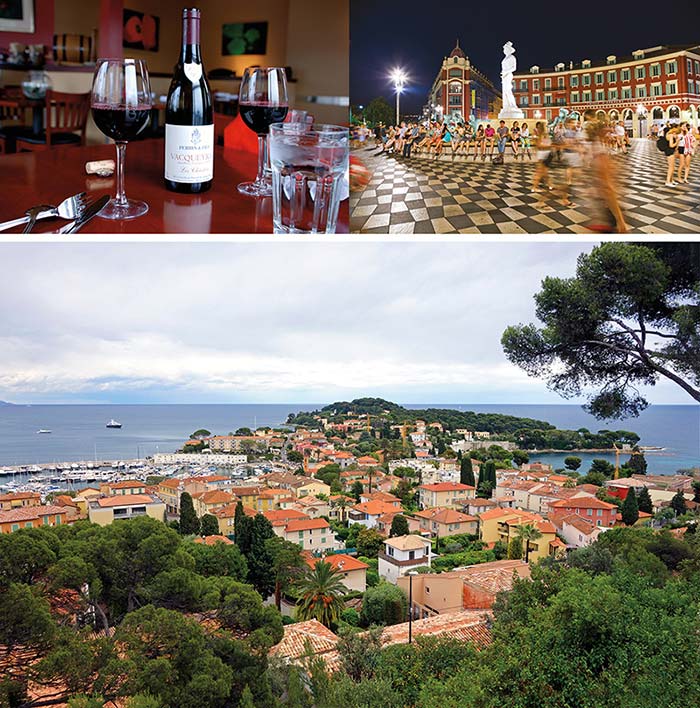
The lifeblood of France, nightlife in Nice, peninsular Cap Ferrat—good for hiking
September brings the grape harvest, when small wineries are off-limits to taste-seeking travelers (though good options exist). Late fall delivers beautiful foliage and a return to tranquility.
Winter travel is OK in Nice, Aix-en-Provence, and Avignon, but you’ll find smaller cities and villages buttoned up tight. Sights and tourist-information offices keep shorter hours, and some tourist activities (such as English-language castle tours) vanish altogether.
Thanks to Provence’s temperate climate, fields of flowers greet the traveler much of the year:
May: Wild red poppies (coquelicots) sprout.
June: Lavender begins to bloom in the lower hills of Provence, generally during the last week of the month.
July: Lavender is in full swing in Provence, and sunflowers are awakening. If you can find adjacent fields with lavender and sunflowers, celebrate! Cities, towns, and villages everywhere overflow with carefully tended flowers.
August-September: Sunflowers flourish.
October: In the latter half of the month, the countryside glistens with fall colors (most trees are deciduous). Vineyards go for the gold.
For weather specifics, see the climate chart in the appendix.
Link your destinations into a logical route. Determine which cities you’ll fly into and out of (Lyon, Nice, and Marseille all work well). Begin your search for transatlantic flights at Kayak.com.
Decide if you’ll travel by car or public transportation, or a combination. A car is particularly helpful for exploring the Côtes du Rhône or Luberon (where public transportation is sparse), but is useless in big cities (park it). Trains link cities and many towns easily, while buses reach some places that trains don’t. Minibus tours are handy for regional sightseeing.
Distances are short in this region (for example, one of the longer trips—connecting Arles and Nice—takes only 2.5 hours by car or 4 hours by train). To determine approximate transportation times between destinations, study the driving chart (see the Practicalities chapter) or train schedules (www.bahn.com). If your visit to this region is part of a longer European trip, compare the cost of any long train ride with a budget flight; check Skyscanner.com for intra-European flights.
Figure out how many destinations you can comfortably fit in your time frame. Don’t overdo it—few travelers wish they’d hurried more. Allow enough days per stop (see estimates in “Provence and the French Riviera’s Top Destinations,” earlier). Minimize one-night stands; it can be worth taking a late-afternoon drive or train ride to settle into a town for an extra night. Factor in sufficient time in your itinerary for transportation between destinations.
Staying in a home base (like Arles) and making day trips can be more efficient than changing locations and hotels (though I would not do it at the cost of an overnight in a peaceful village).
Take sight closures into account. Avoid visiting a town on the one day a week its must-see sights are closed. Check if any holidays or festivals fall during your trip—these attract crowds and can close sights (for the latest, visit France’s tourist website, http://us.france.fr).
Give yourself some slack. Every trip, and every traveler, needs downtime for doing laundry, picnic shopping, people-watching, and so on. Pace yourself. Assume you will return.
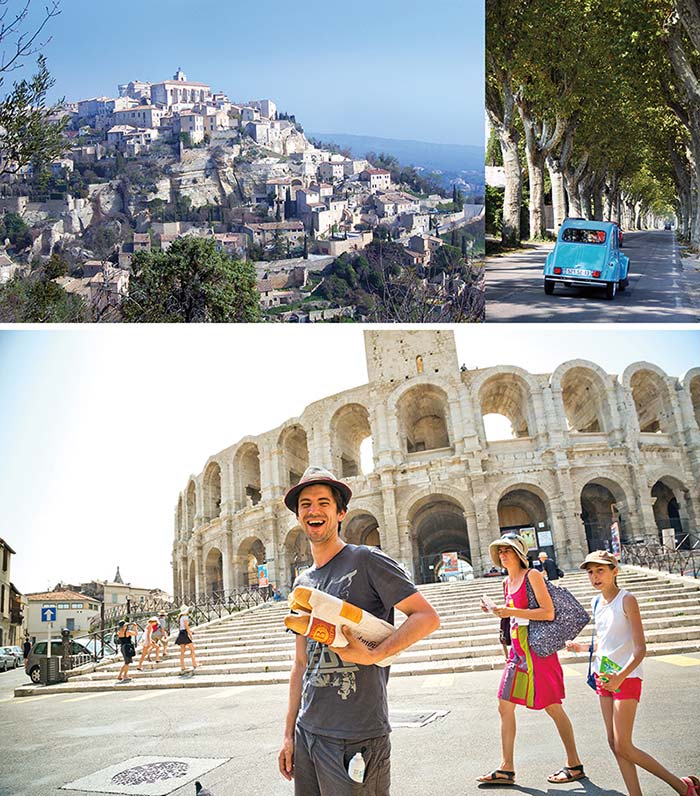
Luberon hill town of Gordes, driving in Provence, enjoying Arles—a good home base
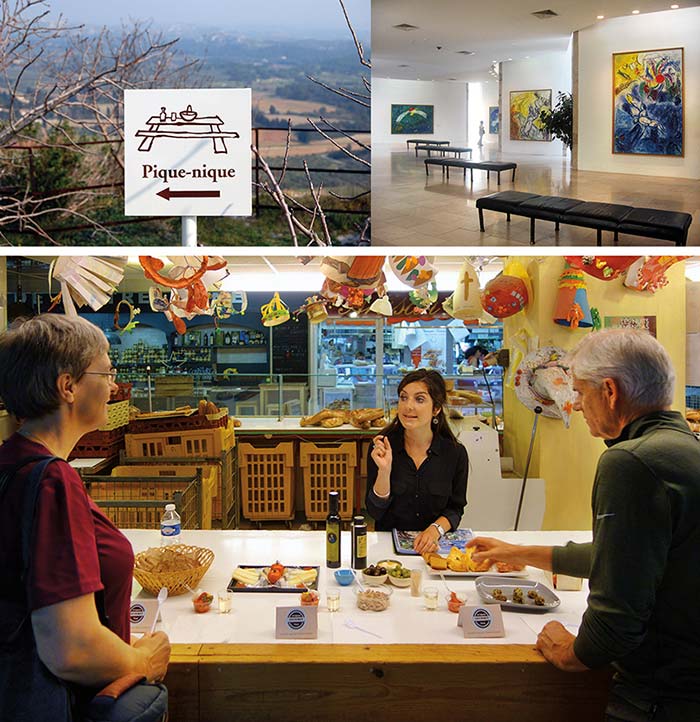
To save money, picnic and sightsee smartly, but splurge for experiences (like a food-tasting tour).
You’ll have a smoother trip if you tackle a few things ahead of time. For more information on these topics, see the Practicalities chapter (and www.ricksteves.com, which has helpful travel tips and talks).
Make sure your passport is valid. If it’s due to expire within six months of your ticketed date of return, you need to renew it. Allow up to six weeks to renew or get a passport (www.travel.state.gov).
Arrange your transportation. Book your international flights. Figure out your main form of transportation within Provence and the Riviera: It’s worth thinking about renting a car or buying train tickets online in advance. (You can wing it once you’re there, but it may cost more.)
Getting a rail pass or booking flights within Europe only makes sense if you are traveling beyond Provence and the Riviera, as distances are short and point-to-point fares are reasonable.
Note that all high-speed trains (TGVs) in France require a seat reservation; book as early as possible, as these trains fill fast. If you’re using a rail pass, book even earlier—there’s a tight limit on seat reservations for passholders. Most trains between Marseille and Nice are TGV, so think about reserving that trip ahead.
Book rooms well in advance, especially if your trip falls during peak season or any major holidays or festivals.
Consider travel insurance. Compare the cost of the insurance to the cost of your potential loss. Check whether your existing insurance (health, homeowners, or renters) covers you and your possessions overseas.
Call your bank. Alert your bank that you’ll be using your debit and credit cards in Europe. Ask about transaction fees, and get the PIN number for your credit card. You don’t need to bring euros for your trip; you can withdraw euros from cash machines in Europe.
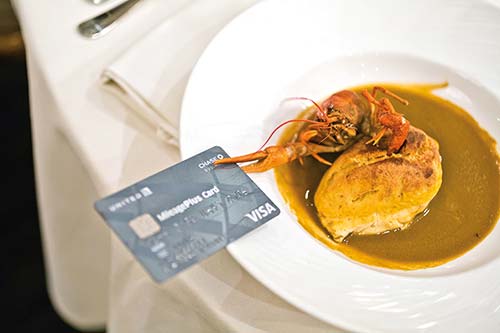
Use your smartphone smartly. Sign up for an international service plan to reduce your costs, or rely on Wi-Fi in Europe instead. Download any apps you’ll want on the road, such as maps, translation, transit schedules, and Rick Steves Audio Europe (see sidebar).
Pack light. You’ll walk with your luggage more than you think, even if you’re driving. I travel for weeks with a single carry-on bag and a daypack. Use the packing checklist in the appendix as a guide.
If you have a positive attitude, equip yourself with good information (this book), and expect to travel smart, you will.
Read—and reread—this book. To have an “A” trip, be an “A” student. Note opening hours of sights, closed days, crowd-beating tips, and whether reservations are required or advisable. Check the latest at www.ricksteves.com/update.
Be your own tour guide. As you travel, get up-to-date info on sights, reserve tickets and tours, reconfirm hotels and travel arrangements, and check transit connections. Visit local tourist information offices (TIs). Upon arrival in a new town, lay the groundwork for a smooth departure; confirm the train, bus, or road you’ll take when you leave (TIs and hotel staff can help with updated road information).
Outsmart thieves. Pickpockets abound in crowded places where tourists congregate. Treat commotions as smokescreens for theft. Keep your cash, credit cards, and passport secure in a money belt tucked under your clothes; carry only a day’s spending money in your front pocket. Don’t set valuable items down on counters or café tabletops, where they can be quickly stolen or easily forgotten.
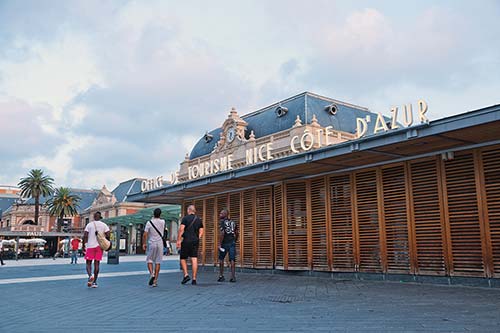
Minimize potential loss. Keep expensive gear to a minimum. Bring photocopies or take photos of important documents (passport and cards) to aid in replacement if they’re lost or stolen.
Beat the summer heat. If you wilt easily, choose a hotel with air-conditioning, start your day early, take a midday siesta at your hotel, and resume your sightseeing later. Churches offer a cool haven (modest attire is appreciated). Take frequent breaks and drink lots of liquids.
Guard your time and energy. If you’re exhausted, take a taxi across town instead figuring out the bus system. And a regional minibus tour can be a good value if it spares you long waits for cheap buses on a hot day. Use the tips throughout this book to organize your sightseeing efficiently.
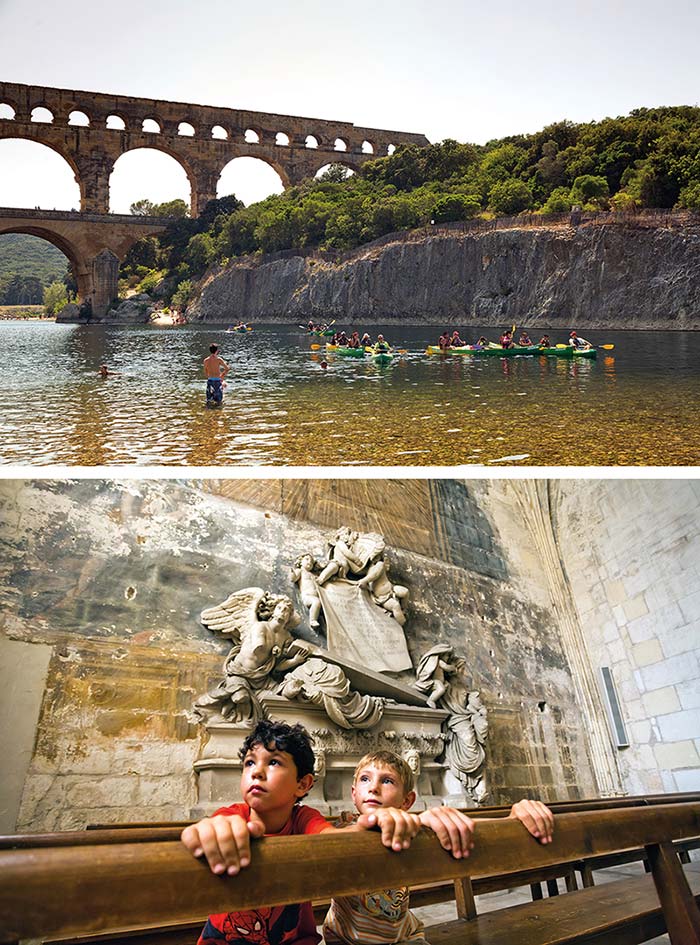
Canoeing at the ancient Pont du Gard, and chilling in a cool, medieval church
Be flexible. Even if you have a well-planned itinerary, expect changes, strikes, closures, sore feet, bad weather, and so on. Your Plan B could turn out to be even better.
Attempt the language. Many French—especially in the tourist trade and in cities—speak English, but if you learn some French, even just a few phrases, you’ll get more smiles and make more friends. Practice the survival phrases near the end of this book, and even better, bring a phrase book.
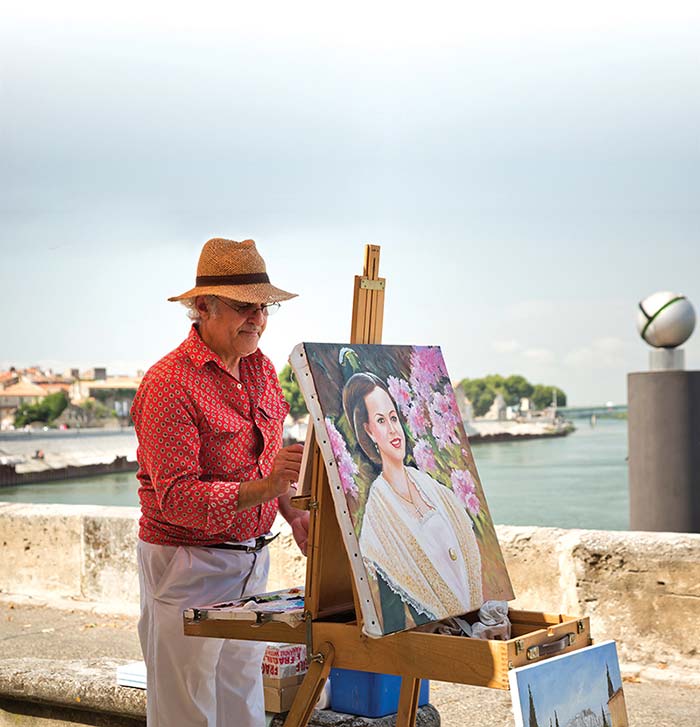
Connect with the culture. Interacting with locals carbonates your experience. Enjoy the friendliness of the French people. Ask questions; most locals are happy to point you in their idea of the right direction. Cheer for your favorite bowler at a boules match, leave no chair unturned in your quest for the best café, find that perfect hill-town view, and make friends with a waiter (it happens). When an opportunity pops up, make it a habit to say “yes.”
Your next stop: Provence and the French Riviera!